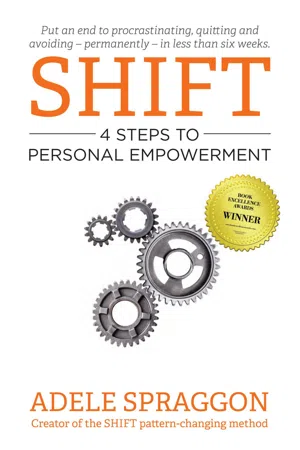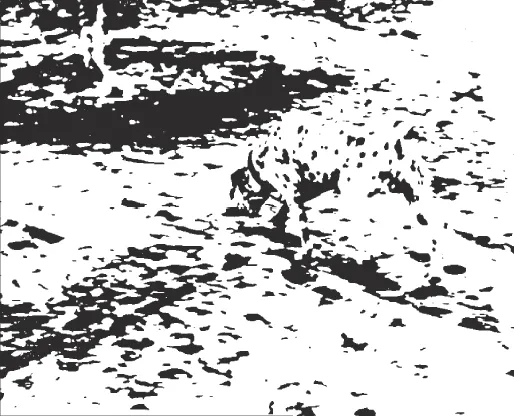![]()
PART ONE:
Understanding Patterns
![]()
Chapter 1:
Patterns, Patterns, Everywhere
Let us begin with an inquiry. What do you see when you look at this picture?
Gregory R. The intelligent eye. New York, McGraw-Hill, 1970
Now, unless you have seen this picture before, it is likely that at first, all you will be able to see is a bunch of dots; but watch as your mind pieces together a pattern.
Take your time. There is a clear and distinct picture among these dots. Do you see it? (If you need a hint, flip to page 6 for the big reveal and then meet me back here).
Congratulations: What you just did was create a pattern. You took what appeared to be random dots, and you turned them into something meaningful.
Human beings do this all the time. We create patterns where none exist: We see elephants and teapots in clouds, men and rabbits live on our moon, and whole villages, birds and mythical creatures dance through the stucco on our ceilings. That is the nature of our brain.
Our brain evolved to take pieces of data and turn them into whole pictures, which is what pattern creation does. This human brain of ours makes associations between events that turn those events into patterns, and it does this so naturally and so quickly that you might miss the enormity of what had to happen for you to be able to see that Dalmatian dog.
Before you could see that dog, you had to take random data (dots on a page) and turn it into something familiar (a dog). You had to take something unknowable and turn it into something knowable – and voila, the meaningless became meaningful.
This natural process is extremely helpful. It means that regardless of how strange and foreign a situation is that you find yourself in, you will find meaning in it, and therefore, will continue to function even in situations of which you have no prior experience. Your patterns provide you with a method through which you can make sense out of the jumble of information that bombards your senses all the time; an ability that is essential to your survival.
However, to really understand patterns, we need to dig a little deeper and ask, how exactly did your brain solve this puzzle? After all, everyone who looks at those dots feels and thinks differently about solving this puzzle, and with good reason, because in efforts to solve this puzzle your brain had to turn to a stored, pre-existing tool available in your subconscious. That tool is your decision-making pattern comprised of a physical sensation, emotion and thought. A pattern that gets activated whenever you encounter a problem-solving situation, such as when you first saw these dots.
What was your pattern for solving this puzzle? Did you tense up? Feel anxious? Think to yourself, ‘I am no good at these things’? Or did you perhaps lean in eagerly, feel a measure of excitement and say to yourself, I love puzzles? And then what was the action that followed? Did you go straight to the “big reveal,” telling yourself you’ll never figure it out? Or did you spend a long time looking at the dots, turning them over and finding all sorts of shapes, refusing to give up until you saw it for yourself? These are all possible patterns that got activated for you when you looked at the dots for the first time.
So let’s break this down. My quitting over and over again had nothing to do with my business or the people I was working with; instead, I had a pattern of quitting that my brain kept presenting as the best course of action, regardless of what was going on in real-time in my life. In my case, the decision-making pattern that preceded my decision to quit was ‘turning stomach; panic; and ‘this sucks, nobody likes it’.
In your case, your reaction to those dots (eagerly leaning in, or anxiously holding back, or whatever else you experienced) was not a result of the dots. Your reaction was instead, the result of a pattern that was created in your past.
The Big Reveal: The answer to the puzzle found on page 3.
The consequence of this is that you experience the events in your life through a filter given by past-created patterns. Which is why, for example, you might get anxiety when going on a first date with someone, even though you haven’t even met them yet – you are simply acting and feeling consistent with an earlier experience. The date you’re about to go on, however, might not at all be like the last one, but that doesn’t matter to the pattern: The previously created pattern invokes thoughts, emotions and behaviours that are consistent with the experience you had in the past.
Now at this point, you might be considering that patterns are detrimental, and so before we continue, let’s explore what the world would be like if your brain couldn’t create patterns.
Take a moment to look around the room you are in. Notice how many objects you can see both in front of you and in your peripheral vision. Now drink in as many of the different shapes, colours, movements and shadows as you can. Try not to lose awareness of any one item as you keep adding more and more items and characteristics to your awareness.
If you manage to maintain an awareness of everything you can see, try to include, as well, everything that you hear. For example, you might become aware of the hum of a refrigerator, the roar of traffic in the distance or the whisper of a TV playing softly in another room. Try as best you can to not drop awareness of anything in either field, visionary or auditory. Are you still doing okay?
Increase your level of awareness by adding in touch. Without losing awareness of anything in your field of vision or your field of hearing, add in the touch of the chair under you, your feet touching the floor and your arms resting on your lap.
What do you notice?
Of course, this is an impossible task; most people describe it as feeling like they are about to explode. Human beings have, what is best described, as a “shifting awareness.” What this means is that our awareness fades in and out. The more attention we place on one thing, or on one sense, the more other things, and other senses, fade into the background. Not a bad thing; our ability to shift our awareness in this manner is a gift, for, without it, we would be overwhelmed by all of the activity around us and be rendered helpless. This capacity is so central to how we operate and so readily available that we tend to overlook how remarkable it is.
And yet what a keen trick. Did you notice as you drank in the room around you a few moments ago that little of what was occurring was of any relevance to what you were doing? The fact that you tuned out the hum of the refrigerator, the movement of the leaves outside your window and the slight fluctuations in room temperature, allowed you to give your full attention to the task at hand. Truthfully, the majority of what is occurring around you and within you does not require your awareness and therefore it ought to be ignored. It is right that you go about your day mostly unaware of the overwhelming amount of activity (the chaos) that is around you. Creating patterns allows you to get on with things.
Your brain has evolved to create patterns for a reason. If it were not for patterns, action would be impossible. It is not that you would take wrong actions; you would not be able to take any action at all. So, as you can see, pattern creation provides enormous benefits. However, this same phenomenon also inherently has a limitation built into it. Rather than explaining what this limitation is, I’ll let you experience it directly for yourself. Now that you have created the Dalmatian, try not to see it:
That’s not so easy.
You see, creating patterns is the easy part. The difficult part is to undo a pattern once you have created it. Having now created your personal Dalmatian, it follows you around, just like any loyal dog. The same effect occurs with all your patterns. Patterns are so persistent in fact, that even if your grown-up, logical self can see that a pattern isn’t working, you can’t undo it. It’s like trying to undo the Dalmatian in the picture once you have seen it.
Let’s say you have a fear of public speaking. Fear of public speaking is a pattern. Logically, you may know that standing on a stage can’t harm you—that you won’t be hurt, killed or maimed—and yet, the fear remains. This is the power of patterns.
Your patterns operate as they do regardless of whether they provide positive or negative outcomes for you. It is of little consequence whether you desire a particular pattern or whether it is working to your benefit or your detriment. Patterns do what patterns do; they run the show.
Patterns explain why people sometimes behave out of character and they help us to understand why two people can be in the same situation and have such different responses. The possibilities within patterns are endless. Patterns are what makes each of us unique: Patterns provide us with our different perspectives. No two of us has the same combination of patterns operating in our subconscious minds. To understand this fully, let’s look at how our patterns originate.
THE ORIGIN OF PATTERNS
How and when did you create your pre-existing, decision-making patterns? How did you come to be anxious or confident about problem-solving, convinced you are good or bad at math, eager to do your taxes or able to procrastinate endlessly, or any other of the countless decisions you make every day?
When you were little, your brain automatically created lots of patterns. You didn’t have any when you were born, and so each new situation required you to create a brand new response to it. Once you successfully navigated each situation you found yourself in, (and when I say “successfully,” I simply mean you survived), you took the pattern that you had formed at that time, and you stored it away for future use. In a remarkably short period (within your childhood years), you assessed the entire world around you, and you created a databank of patterns that you could draw on as you were growing up.
Here is a closer look at how this happens: Pretend for a moment that you are three years old and your father takes you into a large music store. As you enter the store, you find yourself engulfed by the cacophony of sights and sounds. There are instruments everywhere: pianos, guitars, drum sets and string instruments, each strategically placed in their section. Children and adults are coming and going, and raised voices compete within the acoustics.
As you wander the store, distracted by all the commotion, you suddenly find that you are no longer by your father’s side. You desperately spin in circles and terror grows in the pit of your stomach. You start to wail.
Decades pass, and you forget all about the minor incident. One day, you enter a kitchen store in search of a new tea kettle and you are impressed by the size of the store. It has kitchen appliances, gadgets, pots and pans and bakeware, all divided by sections. It is close to the holidays, and the store is busier than usual. You periodically hear Christmas carols over the chatter of the many conversations around you.
The store has an interesting layout: Only display items are located at the consumer’s level, which means that for you to make a purchase, a store clerk must retrieve the inventory from the upper shelves for you. You wait as the clerk locates the rolling stepladder, positions it in place and climbs the steps to reach for the box you requested high above your head.
As you look up, your mind doesn’t consciously register the tattoo of the guitar on the clerk’s forearm, revealed as his sleeve pulled back in the stretch, but the pattern running in your subconscious mind picks up on it immediately. Suddenly you feel irritated. You say to yourself that you have places to be. What a stupid system, you think. “This is taking far too long.” Despite almost having the item in hand, you leave the store without your much-needed kettle.
Let’s look at what happened: Walking through the doors your senses drank in the size of the room, the height of the ceiling, the noises, the people, the music, the shadows, the sounds, the smells, and such. Your unconscious mind turned first to your pattern box and selected from that box the pattern that most closely aligned with the situation. In this case, the one your brain selected is the one that was created decades earlier as you had walked through the doors of the music store holding your father’s hand.
The slight tension and uneasiness of the pattern went mostly unnoticed; that is until a glimpse of the tattoo in the shape of a guitar reminded the pattern of the guitars in the music store you had walked into so long ago. Suddenly, the pattern reacted, you felt irritated, and you left the shop emptyhanded. None of it was conscious, of course. Your conscious mind didn’t even acknowledge the guitar. Patterns occur and operate beneath the surface, in the depths of the psyche too deep to fully understand.
Looking at the two situations side by side, it doesn’t make immediate sense how they are connected: You are no longer three years old, a tattoo is not a real guitar, they are two completely different stores, and so on. Even if you could remember the incident in the music store (it was forgotten long ago), the connections between the two situations are minor at best.
Regardless, the pattern you created when you were three years old got activated in your mind and caused you to feel irritated, annoyed and anxious. It was the pattern that was running the show, and it was the pattern that caused you to feel like you needed to get out of there as soon as possible; not the store or the situation itself.
As you can see from this example, patterns have their own “logic” which, to your conscious mind, can appear most illogical. For patterns, speed is of the essence: Your brain must reduce the vast amount of data coming at you into something you can understand as fast as you can.
Human beings started creating patterns out of necessity – it was necessary for survival. As we saw earlier, the purpose of creating patterns is for our brains to make sense out of chaos so that we can ascertain what action to take next. It doesn’t matter to our brains whether or not the patterns that it runs are “good” or “bad” for us, in the sense of whether or not they are going to help us reach our goals, or whether or not they are going to help us take the most favourable action for ourselves and those around us. In the above example, it didn’t matter that you really needed that tea kettle and that it would certainly have been “better” for you to have left the store with it. The pattern acted to remove you from a potentially harmful situation because your subconscious recorded the terror you experienced when you were three years old, and so now there remains a need to protect you from potential harm.
Patterns also don’t care whether or not they’re accurate. In earlier days of human development, when it came to survival, it wasn’t important whether the stripes lurking in the tall grass belonged to a tiger or not; what was important is that you got away fast. If they didn’t belong to a tiger, so be it; you got a bit of exercise. If they did, that quick reaction just saved your life. The purpose of patterns is not truth; the purpose of patterns is to turn the unknown into something knowable and to do ...




